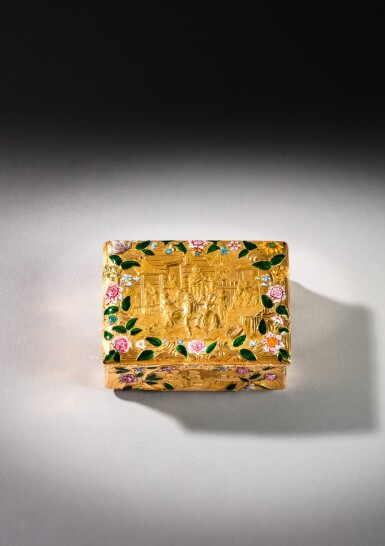
A gold and enamel snuff box, Jean Moynat, Paris, 1745/1746
Premium Lot
Estimate
250,000 - 350,000 EUR
Premium Lot
Lot Details
Description
rectangular with waisted sides, all sides chased with Flemish peasants making merry, after engravings by Jacques-Philippe Le Bas (1707-1783) after paintings by David Teniers the Younger (1610-1690), within boldly-chased scrollwork on a polished ground, overlaid with translucent green enamel leaves interspersed with brightly-coloured raised enamel roses, sunflowers, dianthus and other flowers, the interior of the lid set with an associated portrait miniature of Maximilian III Joseph, Elector of Bavaria (1727-1777), after Georges Desmarées (1697-1776), painted on vellum, maker's mark, charge and discharge marks of Antoine Leschaudel (1744-1750), Paris date letter E for 1745,
7,7 cm; 3 in. wide
overall weight 200 gr, 6,43 oz
possibly Baron James de Rothschild;
Baron Gustave de Rothschild, his son, collection number R 68;
Baron Robert de Rothschild, inventory number 728;
thence by descent;
Christie's, Geneva, 12th November 1985, lot 74.
The Parisian goldsmith Jean Moynat became a master on 5 October 1745, at which time his address was recorded as rue de Harley. In 1748, he moved to place Dauphine, where he remained for at least four years. Moynat also sponsored the renowned gold box maker Charles Le Bastier when the latter became a master in 1754.
According to Nocq, two substandard bases for the lining of snuff boxes were discovered in Moynat’s workshop in 1747, which the strict Parisian guild subsequently confiscated (Henry Nocq, Le Poinçon de Paris: Répertoire des Maîtres-Orfèvres de la Juridiction de Paris depuis le Moyen Âge jusqu'à la fin du XVIIIe siècle, Paris, 1926–31, vol. III, p. 270).
This minor scandal, however, seems to have been an isolated incident for Moynat’s surviving works demonstrate high quality and standard (both in the literal and figurative sense of the word): see for example a rectangular gold box enamelled with raised peonies and striped ribbons in the Metropolitan Museum (48.187.426) and four examples combining fine enamel paintings with crisp chasing or engine-turning in the Musee du Louvre (Serge Grandjean, Catalogue des tabatières boites et étuis des XVIIIe et XIXe siècles du musée du Louvre, cat. nos 162-165). Moynat’s work is also represented in the Thyssen-Bornemisza collection and the Museum of Fine Arts in Boston.
It has been suggested that the present box may have been commissioned by the French army officer Marc-René d’Argenson, Marquis de Voyer (1721–1782), since all three paintings by David Teniers the Younger (1610–1690) on which the chased scenes decorating the box are based - Réjouissance Flamande, Fête de Village, and Fête Flamande - were formerly in his collection.
The fashion of collecting paintings from the Low Countries was prevalent among French connoisseurs in the eighteenth century, among them the Duc de Choiseul (1719-1785). In 1744, the prominent dealer Edme François Gersaint (1694–1750) remarked in the introduction to the sale catalogue of Louis Quentin de Lorangère’s collection that “l’école flamande… est ici fort à la mode & … plaît universellement” (Haydn Williams, 18th-Century Snuffboxes: The David & Mikhail Iakobachvili Collection, vol. I, London, 2024, p. 135).
Alongside this trend, another dominant collecting taste of the period centred on paintings of sentiment, exemplified in the work of Jean-Baptiste Greuze. His subjects such as L’Oiseau mort also often feature on a smaller scale in enamel on snuff boxes (see for example a box by A. G. Turmine in the Victoria & Albert Museum, M.145-1917).
Several prominent collectors are known to have commissioned miniature versions of their favourite paintings in enamel or ivory or to be chased in gold, such as the present lot. One notable example is a gold-mounted boite-a-miniatures by Jean Ducrollay, featuring ivory miniatures by Jacques Charlier (1706-1790), based on pendant paintings by François Boucher (1703-1770), signed and dated 1750, which were delivered to Madame Pompadour and probably intended for the Chateau de Bellevue. A corresponding box with such miniatures appears in the inventaire of Madame de Pompadour of 1764, suggesting that she owned both the paintings by Boucher and the gold box featuring miniature versions thereof (sold Sotheby’s Geneva, 13 May 2024, lot 1508).
You May Also Like










